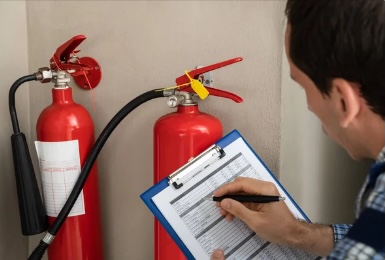Why is it important to carry out monthly inspections of mobile fire extinguishers in the fire prevention strategy?

Inspection is a quick process to visually determine if a fire extinguisher is properly positioned and in operational condition.
Its purpose is to provide a reasonable level of safety, ensuring that the extinguisher is fully charged and effective if necessary.
During the inspection, it is verified that the extinguisher is in place, visible, unlocked, has not been activated or partially or completely discharged, has not been tampered with, and does not present obvious physical damage. In addition, it is evaluated if it has been exposed to corrosive environments or other factors that may affect its operation. For extinguishers equipped with pressure gauges or tamper indicators, inspection should confirm that they are in satisfactory condition. You can also check the maintenance tag to see the date of the last complete maintenance.
To ensure effectiveness, fire extinguisher inspections must be frequent, regular and thorough. They can be carried out daily, weekly or monthly, but no more than 31 days should go by without an inspection, and at least one should be carried out during each calendar month. The frequency of inspections must be adapted to the particular conditions and situations of the property, taking into account the processes carried out, potential risks and specific needs. For example, if an industrial plant paints all of its products, a fire in the paint room could be catastrophic, requiring very frequent inspections.
It is essential to consider the nature of the risks to which the extinguisher is exposed, such as tampering, vandalism, malicious damage, extreme weather conditions, potential for accidental damage, and visual or physical obstructions to its accessibility.
As an alternative to manual inspection, it is possible to monitor fire extinguishers electronically. They are generally connected to fire alarm systems and monitored to ensure that they are in place and that there are no obstructions preventing access to them. The condition of the pressure gauge is also checked. This option is recommended in places where the fire extinguishers have been neglected previously or there is a risk of theft.
Maintenance
Maintenance, unlike inspection, involves a thorough examination of each extinguisher. It includes checking parts, cleaning and replacing any defective parts, reassembling, recharging and, if applicable, pressurizing the extinguisher. Maintenance and recharging must be performed by persons certified to NFPA 10, Standard for Portable Fire Extinguishers.
During maintenance, additional needs may be detected, such as hydrostatic testing of the extinguisher cylinder or other components, and may even require replacement.
Maintenance should be carried out periodically, at least once every 12 months, after each use or when an inspection indicates an obvious need. If signs of corrosion, physical damage, altered parts, nozzle clogging, or agent leakage are observed during an inspection, the extinguisher should be fully serviced, even if it has been recently serviced. NFPA 10 provides specific details on maintenance.
Labels on fire extinguishers have long been used to record maintenance checks. For routine maintenance, a tag is placed on the cylinder to record the date and the inspector's initials. Barcode technology can also be used. Additionally, anti-tamper seals must be used. As long as the seal is intact, it is reasonable to assume that the extinguisher has not been used. However, it is important to note that a stored pressure extinguisher can develop a leak and lose pressure even if the tamper indicator is intact or the pressure gauge indicates "normal." During annual maintenance, the seal is removed by activating the locking device, which is done to ensure proper operation, and a new seal is installed.
Each extinguisher that has undergone maintenance that includes an internal examination or that has been recharged, which involves removing the valve body, must have a service verification collar around the neck of the container. This collar is used to check if the extinguisher has been depressurized and the valve has been removed. Its design requires the valve to be removed for placement, providing convenient visual proof that the extinguisher has been disassembled. The collar allows the date of service to be recorded.
In any functional test of a portable fire extinguisher, four basic elements must be checked: the mechanical parts, such as the extinguisher cylinder and other components; the quantity and condition of the extinguishing agent; the means to expel the agent; and the external condition.
It is necessary to maintain a record that includes the date of purchase, as well as the maintenance dates of each extinguisher. Besides
Luis Ybirma
PCI Specialist // Designs / Consulting / Training / Hydraulic Calculations


